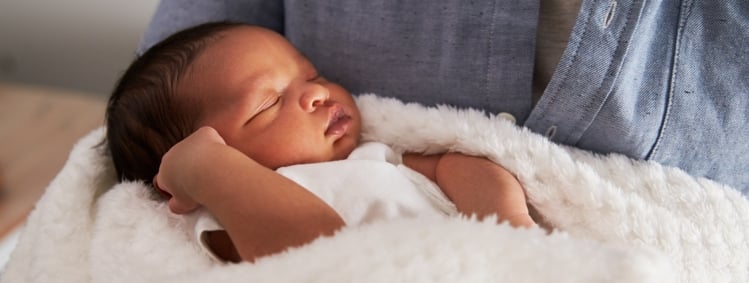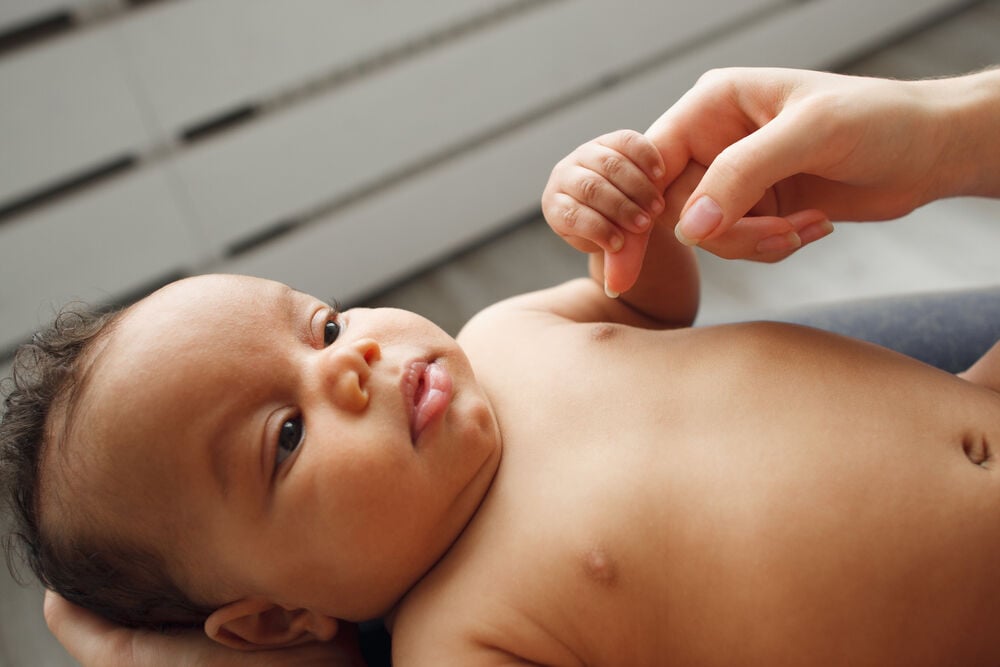Although a newborn can seem incredibly vulnerable and completely needy, at this early stage a baby is actually equipped with several natural reflexes that help protect them. Stay with Flo to learn all about this fascinating topic!
-
Tracking cycle
-
Getting pregnant
-
Pregnancy
-
Help Center
-
Flo for Partners
-
Anonymous Mode
-
Flo app reviews
-
Flo Premium New
-
Secret Chats New
-
Symptom Checker New
-
Your cycle
-
Health 360°
-
Getting pregnant
-
Pregnancy
-
Being a mom
-
LGBTQ+
-
Quizzes
-
Ovulation calculator
-
hCG calculator
-
Pregnancy test calculator
-
Menstrual cycle calculator
-
Period calculator
-
Implantation calculator
-
Pregnancy weeks to months calculator
-
Pregnancy due date calculator
-
IVF and FET due date calculator
-
Due date calculator by ultrasound
-
Medical Affairs
-
Science & Research
-
Pass It On Project New
-
Privacy Portal
-
Press Center
-
Flo Accuracy
-
Careers
-
Contact Us
Newborn Reflexes: 8 Built-In Survival Mechanisms

Every piece of content at Flo Health adheres to the highest editorial standards for language, style, and medical accuracy. To learn what we do to deliver the best health and lifestyle insights to you, check out our content review principles.
What are newborn baby reflexes?
A reflex is defined as an automatic response to a stimulus that occurs without the active participation of the subject. Consider your natural reaction when you accidentally put your hand into scalding water — you reflexively withdraw your hand to protect yourself from harm without conscious thought. This is an example of a reflex.
The benefit of these reflexes is that they allow an automatic and swift response to a stimulus, protecting us from many different types of harm. And they aren’t only active in adults — even newborn babies have a range of reflexes that protect them from potential harm in their immediate environment.
So what reflexes are observed in newborns, and how do they protect babies from potential harm? Let’s read on.
Types of common newborn reflexes
1. Rooting reflex
The rooting reflex is a straightforward one. In response to having their cheek stroked or touched, a newborn baby will turn toward the stimulus and open their mouth toward the stroking.
As you can probably guess, this reflex allows a newborn to successfully latch on to their mom’s breast for feeding.
This reflex is present from birth and becomes less prominent when the baby is three to four months old.
2. Sucking reflex
Like the rooting reflex, the sucking reflex helps a baby to seek food. It prompts automatic sucking when the nipple of a breast or bottle, or even a finger, stimulates their lips. This reflex appears before birth. In fact, if you had an ultrasound test done during pregnancy, you may have seen your baby sucking their thumb. It becomes voluntary at three months.
3. Moro reflex
The Moro reflex is present from birth and provides the newborn with protection from harm in the outside environment. It usually occurs when a baby is startled by a loud sound or movement. If a baby in a supine position is rapidly lowered by about four to eight inches, they will tense their body, open their arms wide, and unclench their fists. Then, they’ll draw their knees into their chest and bring their arms back toward their body with their fists clenched again. The process may conclude with the baby crying loudly.
If you’re watching all of this from the sidelines, it will almost look like your baby is giving themself a hug! But this reflex is short-lived and will pass within a few seconds. Although it’s present from birth, this reflex will happen less often as your baby settles into their new environment outside the womb. By five to six months, it should have disappeared entirely.
4. Grasping or palmar reflex

This simple reflex is triggered by pressing a finger or other object into the palm of a newborn’s hand. They’ll respond by making a fist and gripping strongly. The grasping, or palmar, reflex appears at birth and can last for up to six months. It prepares the infant for grasping actions.
5. Babinski or plantar reflex
This reflex happens when the baby’s sole is gently stroked along the side. You’ll note your baby’s toes spreading out and the big toe moving upwards. The Babinski response starts at birth and usually disappears by the time an infant is nine to 12 months old.
6. Walking or stepping reflex
The walking reflex is triggered by holding the baby upright with their feet in contact with the surface underneath. They’ll respond by lifting one foot after the other, almost as if they’re walking. This response appears at birth and lasts until the infant is around two months old. Some people suspect it can provide early preparation for walking toward the end of the first year.
7. Tonic neck reflex
When a baby is lying on their back and you turn their head gently to one side, the arm on the side toward which their chin is turned will extend, and the opposite arm will bend at the elbow. This is sometimes called the fencing posture.
This reflex is present from birth. But it may fade when your baby is disturbed or crying. It usually disappears between six and seven months, although this varies from baby to baby. It may help prepare an infant for reaching.
8. Galant reflex
The Galant reflex, also called truncal incurvation, is tested by pediatricians by holding the baby face down with one arm and stroking the skin on either side of the spine with the other hand. The baby’s spine will curve in response — the head, feet, and pelvis should move toward the side being stroked. This reflex is present at birth and disappears between two and six months of age.
When to seek medical attention
Your baby may demonstrate most of these reflexes at home, but it’s normal if you don’t observe them in action; the timing may not be ideal, or your baby may simply not be in the mood!
However, if you notice inconsistent responses after several attempts on different days, consult your pediatrician or health care provider for advice. Also, if your baby has a reflex that reappears after some time, seek a medical opinion.
Take a quiz
Find out what you can do with our Health Assistant


Hey, I'm Anique
I started using Flo app to track my period and ovulation because we wanted to have a baby.


The Flo app helped me learn about my body and spot ovulation signs during our conception journey.


I vividly
remember the day
that we switched
Flo into
Pregnancy Mode — it was
such a special
moment.
Real stories, real results
Learn how the Flo app became an amazing cheerleader for us on our conception journey.




